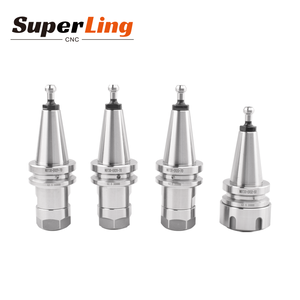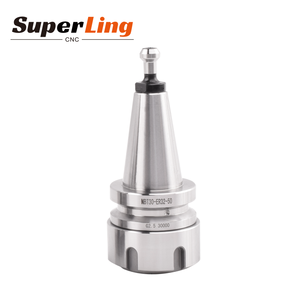(29413 products available)






































































































































































































Cnc lathe tool holder is an important part of CNC machining lathes. Its main function is to hold tool bits, cutting tools, and inserts. It guarantees high stability and precision during CNC machining to ensure that products come out of the right shapes. The following are its various kinds.
A fixed tool holder refers to a tool holder that fixes the position of the tool with a certain rigidity. The tool can only move in rotation. The tool holder and tool bit are commonly linked with screws or pins, while the tool bit must be located in a certain rotational direction of the part. Fixed-type tool holders are ideal for turning and cutting operations where the rotation of the workpiece is required.
An adjustable tool holder can enable the user to adjust tools in different positions or angles. This holder is designed for tooling operations that need cutting from several sides or inclination. The operator can adjust the tool's angle or length to provide the necessary cutting edges. This aspect will very much reduce the need to replace tool holders when cutting materials with different shapes.
Pneumatic tools make use of a compressed air system to either attach or detach the tools they use. They have been popular because of their fast and easy tool change. The tool is mounted using a chuck, which is opened and closed by pressure air. shut away from the system helps in improving productivity, especially in operations involving different tools with frequent changes.
Hydraulic tool holders use fluid pressure to hold the tools tightly. They offer more flexibility than the fixed ones. The tool holder can offer great support even though there is no direct contact between the tool and the holder. Tool holders are best for precision machining. The fluid in the holder ensures that the tool is well placed to absorb any pressure and bend during the cutting process.
Cnc tool holders are produced using different materials depending on the holders' function and usage. The material used to manufacture them determines their strength and hardness to give them various features and benefits.
They contain high carbon levels and alloying elements like chromium, vanadium, and tungsten. These elements make tool steel durable and easily repairable. Its hardness makes it suitable for manufacturing dies, cutters, drills, and lathes like this one. It can retain hardness even in high temperatures. Therefore, it is ideal for use in tools that undergo high friction.
This compound consists of tungsten grains and cobalt binder. It is extremely dense and hard. Besides being one of the hardest materials on Earth, it has corrosion resistance. Because of its unmatched hardness, it is suitable for manufacturing tools like lathe tool holders. Cnc lathe tool holders made of tungsten carbide are wear resistant and have high machining accuracy. Thus, they are handy in industrial machining.
Alumina ceramics comprise alumina powder and various additives. They are wear resistant and have superb hardness, but their bending strength is relatively low. Less bending strength reduces the tendency of alumina ceramics to shatter when in contact with hard materials. The bending strength increases when used with tougher substances. They can also be used to manufacture cutting tools for hard materials like tungsten carbide.
High-speed steel consists of tungsten, molybdenum, and vanadium. HSS blends excellent cutting performance and durability. The steel does not lose its hardness even at high temperatures. This makes it ideal when machining nonferrous metals like copper and aluminum, steel, and plastic material.
A variety of coating materials are available to manufacture the tool holders. For instance, titanium nitride coats the tools with the same properties as the substrate but enhances hardness and wear resistance. Cobalt is occasionally used as a binder to improve thermal conductivity. Coatings are thin but tough. They reduce friction and chemical reactivity. Thus, they are suitable for cutting operations.
Tool holders play a vital role in precision engineering because they directly influence the accuracy and quality of machining operations. The tool holders are applied in the following ways.
Machine holders in precision engineering are crucial for making high-precision components used in aerospace, defence, and satellite applications. Tool holders made from thermally stable materials provide minimal thermal deformation. It makes sure that the tools maintain their positions even when exposed to high temperatures.
Mechanical tool holders help in efficiently machining commonly used aerospace materials like aluminium alloys, titanium alloys, and composites. These tool holders, especially those with anti-corrosion coatings, are capable of machining challenging materials such as composites and titanium. This is because they can withstand chemical and mechanical wear.
In precision engineering, if a customer places an order for a non-standard part with a high degree of precision, special tool holders are produced to support specific needs. Custom tool holders are designed to meet customers' unique requests in terms of dimensional accuracy, material choice, and compatibility with specific tools. These tool holders are manufactured from high-strength steel or custom alloys to meet high-demand machining applications.
Automobile industries use lathe tools to produce shaft sleeves that meet the requirements of a shaft. They are useful in drilling holes and making keyways. They are also applied in the production of pistons. Lathes turn down piston rings to close tolerances, thus providing a perfect fit for gaskets and seals. They construct washers by turning flat stock to the proper thickness and drilling a center hole. Lathes create flywheels from a single piece of metal to steady engine speed.
In the precision industry, tool holders are important for quick prototyping, especially in the production of specialised machine parts for medical equipment. Precision machine parts include specialised screws, gears, and casings used in equipment such as diagnostic machines, surgical tools, and implants. Lathes create prototypes from durable materials like stainless steel, titanium, and brass. They can also create parts from special materials for prototypes. These include aluminium, plastics, and composites.
Consider the following factors to select the right tool holder for a process.
What are the specific requirements of the working space? Will it require set tooling, automatic change, or manual? Fixed tool holders are ideal for types of machines that have limited tooling changes. Adjustable and rotary tool holders are suitable for versatile machines requiring different cuts.
The material of the holder should match the material of the workpiece. Softer materials like aluminum require harder materials for turning. Use sharper tools with smaller cutting edges to work on difficult materials like titanium. Large working materials need larger lathes. When working on intricate designs, use smaller lathes. Automatic lathes are ideal for large production runs. For smaller jobs, manual lathes are suitable.
Which tooling system does the lathe use? ISO, SA, and ASA are common standards. Though most CNC lathes are normally coupled with turret tooling systems and machine types.
There are several characteristics of the lathe that should be considered. The lathe spindle requires tool holders to match spindle noses. Select a tool holder for a live radius. The lathe and turret tool holders for lathes of various generations. Generally, the job lathe should rotate towards the machining side. To produce concentric results, the lathe should have a centre height of ±1.5 mm. For best results, the holder should carry around the tool insert at least 1.5 mm deep.
There are two-budget considerations. The first is the total cost throughout the lifetime of the lathe. And the second lower which is the acquisition cost. Sometimes it is advisable to compile an expensive tool holder that will work for several hours instead of buying a cheap one that will wear quickly. Tool holders that are capable of fast and simple tool changes increase productivity.
A1. They are fabricated from thermally stable materials, ensuring minimal thermal deformation. It guarantees that the tools maintain their positions even in high-heat environments.
A2. Many factors determine the cost of CNC tool holders, including type, material, and brand. For example, a fixed tool holder costs less than $100, while a hydraulic tool holder costs over $600.
A3. They are instrumental in producing components such as shaft sleeves, which aid in drilling holes and keyways. They also produce pistons by turning down piston rings to precise tolerances for gasket and seal fits. CNC lathes create flywheels from a single metal piece to stabilise engine speed.
A4. Tool steel consists of alloying elements like tungsten, vanadium, and chromium. They make it wear-resistant, hard, and tough. They are used in cutting tools, dies, drills, and lathes. Tungsten carbide contains tungsten grains and cobalt binder. It is dense, hard, and abrasion resistant. Normally, they are combined with other materials to manufacture tools like lathe tool holders. They provide unmatched hardness and precision in industrial machining. HSS comprises vanadium, molybdenum, and tungsten. It retains sharpness and hardness even under heat and stress. This makes it ideal when machining nonferrous metals, plastics, and hard woods.
A5. Fluid pressure tightly grips the tool during the process. The fluid serves as a damping medium, absorbing vibrations and cutting forces. It enhances stability and precision during operations, especially in high-gear cutting.